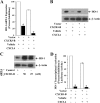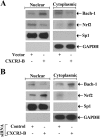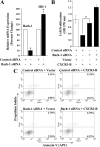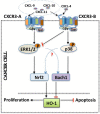A novel CXCR3-B chemokine receptor-induced growth-inhibitory signal in cancer cells is mediated through the regulation of Bach-1 protein and Nrf2 protein nuclear translocation
- PMID: 24366869
- PMCID: PMC3916518
- DOI: 10.1074/jbc.M113.508044
A novel CXCR3-B chemokine receptor-induced growth-inhibitory signal in cancer cells is mediated through the regulation of Bach-1 protein and Nrf2 protein nuclear translocation
Erratum in
-
Correction: A novel CXCR3-B chemokine receptor-induced growth-inhibitory signal in cancer cells is mediated through the regulation of Bach-1 protein and Nrf2 protein nuclear translocation.J Biol Chem. 2020 Jul 24;295(30):10509. doi: 10.1074/jbc.AAC120.014986. J Biol Chem. 2020. PMID: 32709763 Free PMC article. No abstract available.
Abstract
Chemokines and their receptors play diverse roles in regulating cancer growth and progression. The receptor CXCR3 can have two splice variants with opposite functions. CXCR3-A promotes cell growth, whereas CXCR3-B mediates growth-inhibitory signals. However, the negative signals through CXCR3-B in cancer cells are not well characterized. In this study, we found that CXCR3-B-mediated signaling in MCF-7 and T47D breast cancer cells induced apoptotic cell death. Signals through CXCR3-B decreased the levels of the antiapoptotic proteins Bcl-2 and Bcl-xL and increased the expression of apoptotic cleaved poly(ADP-ribose) polymerase. Along with up-regulation in apoptosis, CXCR3-B signals were associated with a decrease in cellular autophagy with reduced levels of the autophagic markers Beclin-1 and LC3B. Notably, CXCR3-B down-regulated the expression of the cytoprotective and antiapoptotic molecule heme oxygenase-1 (HO-1) at the transcriptional level. There was an increased nuclear localization of Bach-1 and nuclear export of Nrf2, which are important negative and positive transcription factors, respectively, for HO-1 expression. We also observed that CXCR3-B promoted the activation of p38 MAPK and the inhibition of ERK-1/2. CXCR3-B could not induce cancer cell apoptosis at the optimal level when we either inhibited p38 activity or knocked down Bach-1. Further, CXCR3-B-induced apoptosis was down-regulated when we overexpressed HO-1. Together, our data suggest that CXCR3-B mediates a growth-inhibitory signal in breast cancer cells through the modulations of nuclear translocation of Bach-1 and Nrf2 and down-regulation of HO-1. We suggest that the induction of CXCR3-B-mediated signaling can serve as a novel therapeutic approach where the goal is to promote tumor cell apoptosis.
Keywords: Apoptosis; Chemokines; Heme Oxygenase; Nrf2; Nuclear Transport; Signal Transduction; Signaling.
Figures








Similar articles
-
The Antitumor Mechanism of Paeonol on CXCL4/CXCR3-B Signals in Breast Cancer Through Induction of Tumor Cell Apoptosis.Cancer Biother Radiopharm. 2018 Aug;33(6):233-240. doi: 10.1089/cbr.2018.2450. Epub 2018 May 30. Cancer Biother Radiopharm. 2018. PMID: 29847158
-
CXCR3-B can mediate growth-inhibitory signals in human renal cancer cells by down-regulating the expression of heme oxygenase-1.J Biol Chem. 2010 Nov 19;285(47):36842-8. doi: 10.1074/jbc.M110.170324. Epub 2010 Sep 20. J Biol Chem. 2010. PMID: 20855888 Free PMC article.
-
Prolonged cigarette smoke exposure decreases heme oxygenase-1 and alters Nrf2 and Bach1 expression in human macrophages: roles of the MAP kinases ERK(1/2) and JNK.FEBS Lett. 2009 Nov 3;583(21):3508-18. doi: 10.1016/j.febslet.2009.10.010. Epub 2009 Oct 12. FEBS Lett. 2009. PMID: 19822148
-
Can the interplay between autophagy and apoptosis be targeted as a novel therapy for Parkinson's disease?Neurobiol Aging. 2021 Apr;100:91-105. doi: 10.1016/j.neurobiolaging.2020.12.013. Epub 2020 Dec 24. Neurobiol Aging. 2021. PMID: 33516928 Review.
-
Stress Activated MAP Kinases and Cyclin-Dependent Kinase 5 Mediate Nuclear Translocation of Nrf2 via Hsp90α-Pin1-Dynein Motor Transport Machinery.Antioxidants (Basel). 2023 Jan 26;12(2):274. doi: 10.3390/antiox12020274. Antioxidants (Basel). 2023. PMID: 36829834 Free PMC article. Review.
Cited by
-
Novel roles of c-Met in the survival of renal cancer cells through the regulation of HO-1 and PD-L1 expression.J Biol Chem. 2015 Mar 27;290(13):8110-20. doi: 10.1074/jbc.M114.612689. Epub 2015 Feb 2. J Biol Chem. 2015. PMID: 25645920 Free PMC article.
-
Bach1 Represses Wnt/β-Catenin Signaling and Angiogenesis.Circ Res. 2015 Jul 31;117(4):364-375. doi: 10.1161/CIRCRESAHA.115.306829. Epub 2015 Jun 29. Circ Res. 2015. PMID: 26123998 Free PMC article.
-
The Extended N-Terminal Domain Confers Atypical Chemokine Receptor Properties to CXCR3-B.Front Immunol. 2022 Jun 1;13:868579. doi: 10.3389/fimmu.2022.868579. eCollection 2022. Front Immunol. 2022. PMID: 35720349 Free PMC article.
-
Phosphoproteomic characterization of the signaling network resulting from activation of the chemokine receptor CCR2.J Biol Chem. 2020 May 8;295(19):6518-6531. doi: 10.1074/jbc.RA119.012026. Epub 2020 Apr 2. J Biol Chem. 2020. PMID: 32241914 Free PMC article.
-
Divergent roles of CXCR3 isoforms in promoting cancer stem-like cell survival and metastasis.Breast Cancer Res Treat. 2015 Jan;149(2):403-15. doi: 10.1007/s10549-014-3229-7. Epub 2014 Dec 24. Breast Cancer Res Treat. 2015. PMID: 25537642 Free PMC article.
References
-
- Zlotnik A., Yoshie O. (2000) Chemokines. A new classification system and their role in immunity. Immunity 12, 121–127 - PubMed
-
- Balkwill F., Mantovani A. (2001) Inflammation and cancer. Back to Virchow? Lancet 357, 539–545 - PubMed
-
- Vandercappellen J., Van Damme J., Struyf S. (2008) The role of CXC chemokines and their receptors in cancer. Cancer Lett. 267, 226–244 - PubMed
-
- Zipin-Roitman A., Meshel T., Sagi-Assif O., Shalmon B., Avivi C., Pfeffer R. M., Witz I. P., Ben-Baruch A. (2007) CXCL10 promotes invasion-related properties in human colorectal carcinoma cells. Cancer Res. 67, 3396–3405 - PubMed
-
- Walser T. C., Rifat S., Ma X., Kundu N., Ward C., Goloubeva O., Johnson M. G., Medina J. C., Collins T. L., Fulton A. M. (2006) Antagonism of CXCR3 inhibits lung metastasis in a murine model of metastatic breast cancer. Cancer Res. 66, 7701–7707 - PubMed
Publication types
MeSH terms
Substances
Grants and funding
LinkOut - more resources
Full Text Sources
Other Literature Sources
Medical
Research Materials
Miscellaneous

